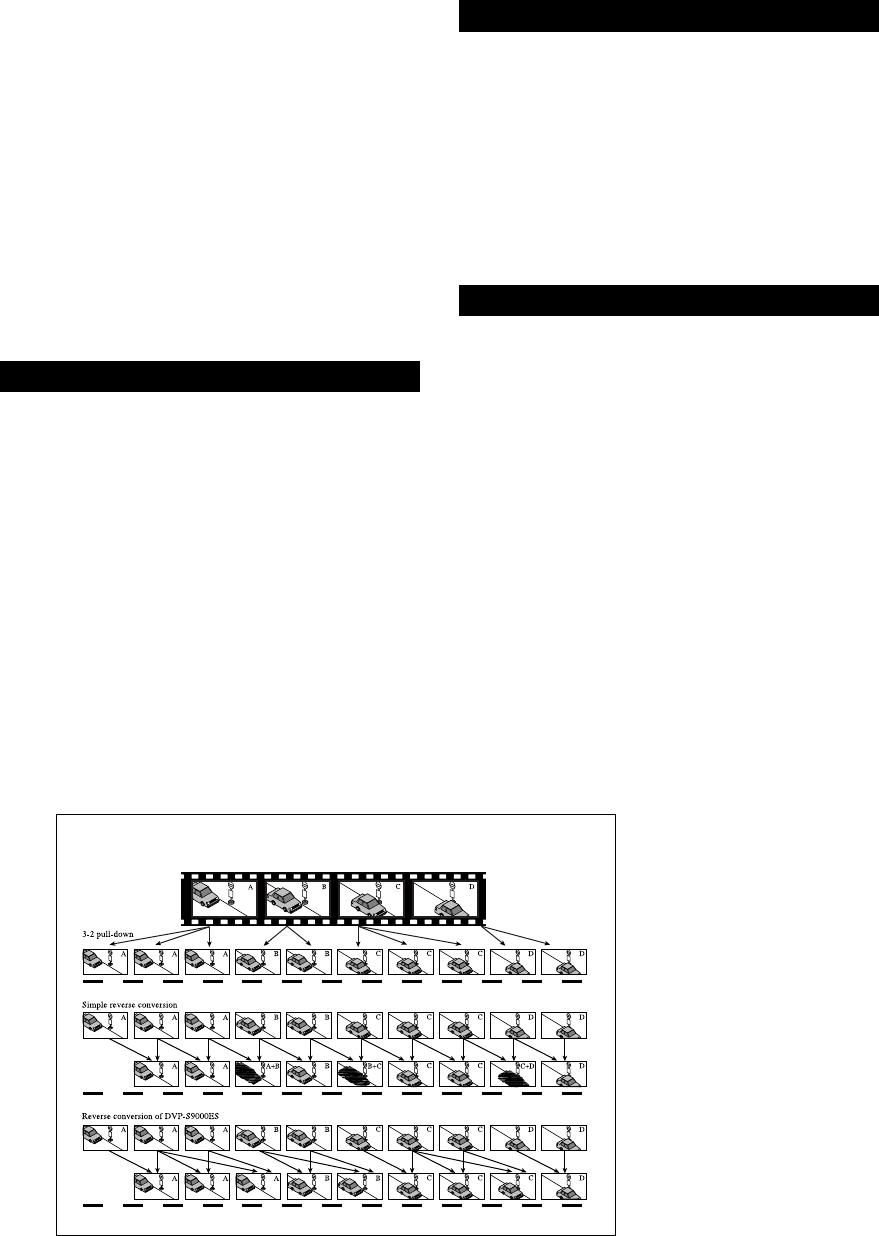
6
1. High accuracy film detection with FFRF.
2. Dedicated microprocessor for motion detecting.
3. Separate 3-2 reverse conversion algorithms for video and film-
originated DVDs.
4. Full 3-2 reverse conversion.
Together, these advances enable the Sony DVP-S9000ES to
deliver more consistent, more satisfying, more seamless 525P
output with a wider variety of discs. Flicker, motion artifacts and
3-2 cadence glitches are controlled. The visibility of scanning
lines is minimized. Connect the DVP-S9000ES to a 525P-
compatible television, monitor or projector and prepare to be
amazed. You’ll approach the full glory of high definition picture
quality — from today’s standard DVDs!
Smooth 525P output depends on proper 3-2 reverse conversion.
To accomplish this, the player must accurately reconstruct the 3-
2 cadence of the original master videotape. The key to achieving
this is the sequence of First Field Repeat Flags (FFRFs) on the
DVD. Most DVDs contain a complete set of FFRFs. But
inconsistencies in videotape editing, MPEG encoding and DVD
authoring can result in irregularity in the FFRF signal. As
reviewers have already noticed, this can cause even highly
regarded players to stumble, producing visible motion artifacts.
Sony’s DVP-S9000ES overcomes the problem. The player
performs high-speed detection of missing flags, with flag look-
ahead and non-contiguous point detection. The player then
reconstructs missing flags, for smooth, uninterrupted playback of
DVD movies.
The FFRF signal is designed to be present in all film-originated
DVDs — and absent from all video-originated DVDs. Yet even
in the most extreme case, where a film-originated DVD contains
no FFRFs at all, Sony’s dedicated microprocessor with motion
detection can elicit full performance. The microprocessor can
judge the correlation between fields very accurately,
supplementing the FFRF detection system. As a result, the Sony
DVP-S9000ES can read and reproduce even this worst-case disc
in beautiful, stable 525P.
“A” and “B” fields originated on film represent a single slice of
time and have no motion between them. “A” and “B” fields
originated on video represent different slices of time and can
have significant motion. For this reason, film and video require
substantially different algorithms in Interlace-to-Progressive
conversion. Conversion of film-originated DVDs can use
relatively simple de-interlacing. Conversion of video-originated
DVDs requires a more complex motion-adaptive algorithm.
The correct application of the video algorithm requires the
precise identification of motion between pairs of video fields.
The DVP-S9000ES accomplishes this with the motion detection
microprocessor. It uses the external graphics memory of the I-to-
P conversion circuit to read pixel-level motion of each field at
high speed. Then the microprocessor instantly selects the
appropriate conversion algorithm for video, for film or for still
scenes with no motion.
High Accuracy Film Detection with FFRF
Separate Algorithms for Video and Film Originated DVDs
Fig. 3: At the top are the original
film frames, showing a car
moving down the street. Next
comes the original 3-2
pulldown. Simple frame
memory reverse conversion
results in a motion blur every
time fields from different film
frames are combined. (This
occurs for two out of every five
frames — or 40% of the time!)
Sony’s DVP-S9000ES, bottom,
uses full 3-2 reverse conversion,
to preserve the integrity of the
original film frames.
3-2 Reverse Conversion
Dedicated Microprocessor with Motion Detection


















